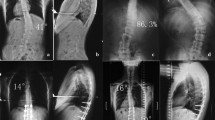Abstract
Background
Controversy still exists around surgical strategies for Lenke type 1C and 2C curves with primary thoracic and compensatory lumbar curves in adolescent idiopathic scoliosis (AIS). The benefit of selective thoracic fusion (STF) for these curve types is spontaneous lumbar curve correction while saving more mobile lumbar segments. However, a risk of postoperative coronal decompensation after STF has also been reported. This multicenter retrospective study was conducted to evaluate postoperative behavior of thoracolumbar/lumbar (TLL) curve and coronal balance after posterior thoracic fusion for Lenke 1C and 2C AIS.
Methods
Twenty-four Lenke 1C and 2C AIS patients who underwent posterior thoracic fusion were included. The mean age of patients was 15.7 years old at time of surgery. Constructs used for surgery in all cases were pedicle screw constructs ending at L3 or above. Radiographic measurements were performed on Cobb angles of the main thoracic and TLL curves and coronal balance. Factors related to final Cobb angle of TLL curve and postoperative change of coronal balance were investigated.
Results
Mean Cobb angles for main thoracic and TLL curves were 59.0° and 43.9° preoperatively, and were corrected to 21.5° and 22.0° at final follow-up, respectively. Mean coronal balance was −5.6 mm preoperatively and was corrected to −14.6 mm at final follow-up. Final Cobb angle of TLL curve was significantly correlated with immediate postoperative Cobb angle of main thoracic curve and tilt of lowest instrumented vertebra (LIV). Postoperative change of coronal balance was significantly correlated with selection of LIV relative to stable vertebra.
Conclusion
Spontaneous correction of TLL curve occurred consistently by correcting the main thoracic curve and making the LIV more horizontal after posterior thoracic fusion for Lenke 1C and 2C AIS. The more distal fixation to stable vertebra resulted in coronal balance shifting more to the left postoperatively.

Similar content being viewed by others
References
Moe JH. A critical analysis of methods of fusion for scoliosis. An evaluation in two hundred and sixty-six patients. J Bone Joint Surg Am. 1958;40(3):529–54.
King HA, Moe JH, Bradford DS, Winter RB. The selection of fusion levels in thoracic idiopathic scoliosis. J Bone Joint Surg Am. 1983;65(9):1302–13.
Lenke LG, Betz RR, Bridwell KH, Harms J, Clements DH, Lowe TG. Spontaneous lumbar curve coronal correction after selective anterior or posterior thoracic fusion in adolescent idiopathic scoliosis. Spine. 1999;24(16):1663–72.
Dobbs MB, Lenke LG, Walton T, Peelle M, Rocca GD, Steger-May K, Bridwell KH. Can we predict the ultimate lumbar curve in adolescent idiopathic scoliosis patients undergoing a selective fusion with undercorrection of the thoracic curve? Spine. 2004;29(3):277–85.
Lenke LG, Bridwell KH, Baldus C, Blanke K. Preventing decompensation in King type II curves treated with Cotrel-Dubousset instrumentation. Strict guidelines for selective thoracic fusion. Spine. 1992;17(8S):S274–81.
Thompson JP, Transfeldt EE, Bradford DS, Ogilvie JW, Boachie-Adjei O. Decompensation after Cotrel-Dubousset instrumentation of idiopathic scoliosis. Spine. 1990;15(9):927–31.
McCance SE, Denis F, Lonstein JE, Winter RB. Coronal and sagittal balance in surgically treated adolescent idiopathic scoliosis with the King II curve pattern. A review of 67 consecutive cases having selective thoracic arthrodesis. Spine. 1998;23(19):2063–73.
Demura S, Yaszay B, Bastrom TP, Carreau J, Newton PO, Harms Study Group. Is decompensation preoperatively a risk in Lenke 1C curves? Spine. 2013;38(11):E649–55.
Wang Y, Bünger CE, Wu C, Zhang Y, Hansen ES. Postoperative trunk shift in Lenke 1C scoliosis. What causes it? How can it be prevented? Spine. 2012;37(19):1676–82.
Green DW, Lawhorne TW III, Widmann RF, Kepler CK, Ahern C, Mintz DN, Rawlins BA, Burke SW, Boachie-Adjei O. Long-term magnetic resonance imaging follow-up demonstrates minimal transitional level lumbar disc degeneration after posterior spine fusion for adolescent idiopathic scoliosis. Spine. 2011;36(23):1948–54.
Chang KW, Chang KI, Wu CM. Enhanced capacity for spontaneous correction of lumbar curve in the treatment of major thoracic-compensatory C modifier lumbar curve pattern in idiopathic scoliosis. Spine. 2007;32(26):3020–9.
Takahashi J, Newton PO, Ugrinow VL, Bastrom TP. Selective thoracic fusion in adolescent idiopathic scoliosis. Factors influencing the selection of the optimal lowest instrumented vertebra. Spine. 2011;36(14):1131–41.
Conflict of interest
The authors declare that they have no conflict of interest.
Author information
Authors and Affiliations
Corresponding author
About this article
Cite this article
Ishikawa, M., Cao, K., Pang, L. et al. Postoperative behavior of thoracolumbar/lumbar curve and coronal balance after posterior thoracic fusion for Lenke 1C and 2C adolescent idiopathic scoliosis. J Orthop Sci 20, 31–37 (2015). https://doi.org/10.1007/s00776-014-0655-7
Received:
Accepted:
Published:
Issue Date:
DOI: https://doi.org/10.1007/s00776-014-0655-7




